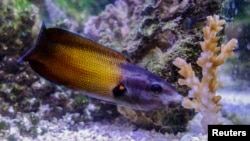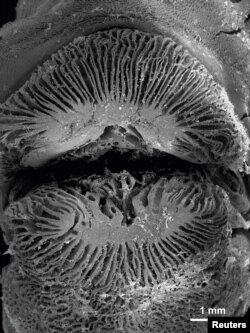A kiss from a colorful reef fish called a tubelip wrasse is no one's idea of romance, being so full of slime and suction, but it is perfectly suited for eating a hazardous diet using one of the animal kingdom's most unique feeding strategies.
Scientists on Monday described for the first time how the fish thrives in the Indian Ocean and central-western Pacific as one of the few creatures capable of dining on corals, one of the planet's most difficult menu items.
Corals are marine organisms boasting thin, mucus-covered flesh that contains venomous, stinging cells spread over a razor-sharp skeleton. Of the more than 6,000 fish species that live on reefs, only about 128 eat corals. Scientists knew that the yellow-and-purple tubelip wrasse was one of them, but how it did it was a mystery.
The researchers used a scanning electron microscope to determine the structure of its fleshy, pouty-looking lips and high-speed video to learn what it does while feeding.
"Kissing the mucus and flesh of corals with self-lubricating lips was not what we were expecting," said marine biologist Víctor Huertas of James Cook University in Australia.
The thick lips of the fish, which reaches about 7 inches (18 cm) long, were found to be made of a tightly packed series of thin folds of tissue, like the underside of a mushroom top, covered in slime from mucus-secreting cells.
"To our knowledge, this type of lip has never been recorded before," James Cook University marine biologist David Bellwood said.
They discovered that the fish approaches the coral slowly and inspects its surface, protrudes its jaws, then produces powerful suction as its lips make contact with the coral for two-100ths of a second. In that scant time, it ingests the flesh and coral mucus off the coral skeleton.
"It looks exactly like a quick kiss with a distinctive 'tuk' sound," Huertas said, "often leaving a coral 'hickie,' which is actually a patch of flesh sucked off the skeleton."
"It would be a good basis for a horror movie," Bellwood added.
The mucous coat may protect the lips from the stinging cells, help to seal them against the coral surface to enhance suction force and serve as a conveyor belt that captures the coral mucus and the stinging cells being ingested, the researchers said.
The research was published in the journal Current Biology.






